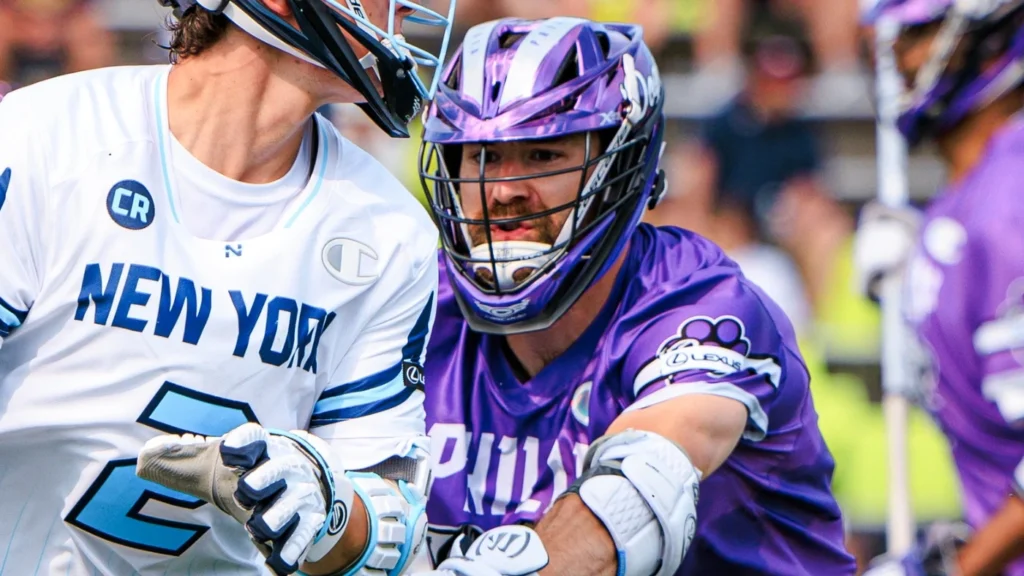
Hall of Fame Inductee: Mark Millon
By Chris Rosenthall | Feb 16, 2022
I learned to play lacrosse in a place we called The Pit, a half-grass, half-dirt practice field at the bottom of the hill behind my old high school. During individual practice sessions at The Pit, I sharpened my attack skills by practicing a series of moves, each one named after the person I’d seen do it so well I had no choice but to try copying and pasting directly into my own game. A quick step just barely above GLE, followed by a low-to-high rip towards the opposite corner? That was my Rob Kavovit, almost always followed by a jog to the softball field to retrieve my ball. Practicing Jesse Hubbards meant running about eight yards upfield, tossing the ball to myself, curling back to the middle and firing an underhanded bouncer, a re-creation of the overtime game-winner that beat UVA for the 1996 NCAA championship.
Finally, I’d jog over to the wing, sprint towards the cage, break my invisible defenseman’s ankles with a hard right-to-left split, wrench my back like a golfer and unleash a slap-shot-esque lefty rip with all my might. That was the Mark Millon, the shot that won gold for Team USA back in 1998, puzzled MLL goalies in the early 2000s, and inspired a faithful legion of lefty imposters along the way.
Before we continue, let’s clarify something about Millon’s game: That shot may be instantly recognizable, but he was far from a one-note attackman: Mark Millon could initiate an offense from any part of the field, and he was downright surgical with either hand. Furthermore, he was especially skilled in the deadly art of the exclamation point dodge, sprinting from X, blowing by his defender and launching a fadeaway jumper, which, like every other shot he took, was unleashed with every single fiber of his being. That being said, his wing dodge was something different - when you saw him pull his defenseman out to the wing like an alligator dragging its prey into the water? You could practically hear that poor guy whimpering for backup.
With an Iversonian motor and seemingly endless ability to bounce back from bone-crushing late body checks, Mark Millon was the gold standard for attackmen who would most likely never find themselves larger than the person hired to stop him. He was a master of stick protection, understanding when and where to accelerate, and manipulating his angles on the field, a man so dangerous it wasn’t even considered all that brash that he titled his instructional video “Offensive Wizardry.” Not “Helpful Hints,” not “Tips and Tricks,” but “Offensive Wizardry.” It’s just the kind of game that Millon had - the man could make magic happen, and with his help, perhaps you could too.
His Bayhawks fell to the Long Island Lizards in the 2001 championship, but in typical Mark Millon fashion, he picked himself up and bounced back with a vengeance, leading the team with 63 points (44g, 19a) and earning the first of back-to-back Offensive Player of the Year honors the following season. When it came time for the championship rematch, Millon dished out the first assist just 22 seconds into the game, scored the game’s second goal shortly thereafter, and four goals and an assist later, was named championship MVP in Baltimore’s 21-13 victory. Clearly someone who enjoys some good payback, Millon was traded to the Boston Cannons two years later, the 2005 Co-MVP responding by scoring a record 14 points in his first game against his former team. Stepping away as Major League Lacrosse’s all-time leading scorer, Millon played his final complete season in 2006, and while he’s known for being one of the greatest offensive players the game has ever seen, his legacy has also been secured as one of its most prolific teachers - not only through his signature instructional camps, but through those of us who simply watched his moves and immediately ran outside to break them down until sunset.
Regardless of how the knowledge has been passed down, Mark Millon’s influence remains easy to identify all over the modern lacrosse landscape. For every exclamation point from the likes of Jordan Wolf, or ankle-breaking wing dodge from Grant Ament, rest assured that many of today’s greatest attackmen began their journeys in similar fashion: All alone on their local fields, just practicing their Mark Millons.




